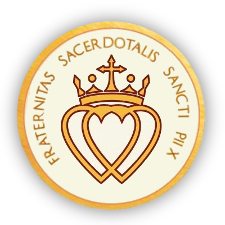
The Society of St. Pius X is an international traditionalist Catholic organization with a non-canonical status. That is, they are not in full communion with Rome. SSPX was formed in 1970 in response to Vatican II, if not the actual documents of Vatican II then in response to the manner in which its general recommendations have been implemented. This is often referred derisively by many (including me) as the “spirit of Vatican II” because it represents extraordinary steps influenced by progressives beyond the actual teaching of the Church. I have written about some of these in my 2 part piece on reform the reform early last year (part 1 and part 2).
Wikipedia has a fairly balanced article on the SSPX.
In addition to the doctrinal and discipline issues raised, SSPX also celebrates Holy Mass much as it was before Vatican II. That is not an issue as Vatican II did NOT in any way replace the traditional Mass, now referred to as the extraordinary form. In point of fact, our Holy Fathers have made this clear in Ecclesia Dei Adflicta, Summorum Pontificum (with accompanying letter) and Universae Ecclesiae. Unlike the SSPX, the Priestly Fraternity of Saint Peter (FSSP) also celebrates the Tridentine Mass but in full communion with Rome.
Pope Benedict has been working tirelessly (for years now) with the SSPX to heal this split and to restore them to full communion. This is important for Christian unity, but also for another reason – we need them. The SSPX could be a key contributor to the new evangelization, having themselves grown large by boldly teaching traditional Catholic beliefs. They currently have over 550 priests in 30+ countries (active in 30+ more), 200 seminarians (6 seminaries), 88 schools and 2 university level institutes.
From all reports, it looks like a solution is close at hand. Perhaps the biggest issue remaining is their canonical status. That is, how exactly would they exist within the Church? The SSPX is concerned (rightfully so in my opinion) that they could be forced to accept practices at odds with tradition. They need a structure that assures them that will not happen. We need a structure that provides for their contribution to the renewal of the Church.
There is another serious complication. The SSPX has been separate now for over 40 years and not all elements may be willing to reunite. They are organized under 4 bishops, Bishop Bernard Fellay (the society’s superior general), Bishop de Galarreta, Bishops Tissier de Mallerais and Bishop Richard Williamson. Bishop Fellay has led the discussion with Rome and is optimistic. The other 3 much less so. How this may influence SSPX priests, religious, laity and institutions is unknown should a schism occur within the SSPX.
Bishop Fellay speaks frankly with the Catholic News Service (an “editorially independent and a financially self-sustaining division of the USCCB”):
My personal hope is that reunion with the SSPX, in whole or part, can be announced in October to coincide with the 50th anniversary of Vatican II. In my ideal world, related to such an announcement would also be the publication of a Syllabus of Errors on Vatican II. Such a document would clarify Vatican II teaching and identify common errors made in its name. On this point:
Keeping in mind the now decades-long experience of interpretations that are doctrinally and pastorally mistaken and contrary to the bi-millennial continuity of the doctrine and prayer of the faith, there thus arises the necessity and urgency of a specific and authoritative intervention of the pontifical magisterium for an authentic interpretation of the “conciliar texts, with supplementation and doctrinal clarifications; a sort of “Syllabus” of the errors in the interpretation of Vatican Council II. “There is the need for a new Syllabus, this time directed not so much against the errors coming from outside of the Church, but against the errors circulated within the Church by supporters of the thesis of discontinuity and rupture, with its doctrinal, liturgical, and pastoral application.”
Bishop Athanasius Schneider
December 2010
Lord Jesus Christ, at your Last Supper you prayed to the Father that all should be one. Send your Holy Spirit upon all who bear your name and seek to serve you. Strengthen our faith in you, and lead us to love one another in humility. May we who have been reborn in one baptism be united in one faith under one Shepherd. Amen.


























Share Your Thoughts